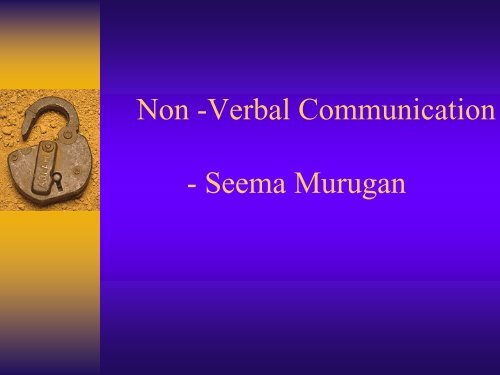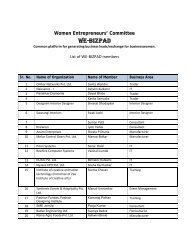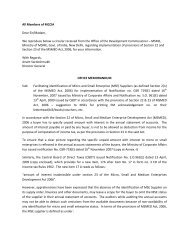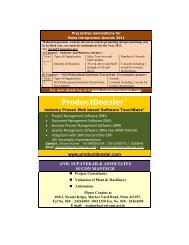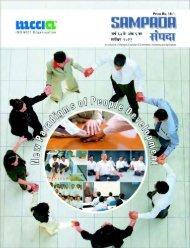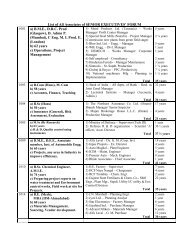Non -Verbal Communication - Seema Murugan
Non -Verbal Communication - Seema Murugan
Non -Verbal Communication - Seema Murugan
You also want an ePaper? Increase the reach of your titles
YUMPU automatically turns print PDFs into web optimized ePapers that Google loves.
<strong>Non</strong> -<strong>Verbal</strong> <strong>Communication</strong><br />
- <strong>Seema</strong> <strong>Murugan</strong>
<strong>Non</strong> -<strong>Verbal</strong> <strong>Communication</strong> : AN OVERVIEW<br />
• INTRODUCTION<br />
• IMPORTANCE<br />
• TYPES OF NON - VERBAL MESSAGES<br />
• BODY LANGUAGE<br />
• INTERPRETING BODY LANGUAGE<br />
• ARTIFACTUAL COMMUNICATION AND COLOR<br />
• SPACE AND DISTANCE / PROXEMICS<br />
• GENDER , DIVERSITY AND TECHNOLOGY<br />
• TIPS TO IMPROVE N-V COMMUNICATION<br />
• VIEW NEXT PPT. ON BODY SPORT<br />
SM / HSS / IIT-KGP 2
NON-VERBAL COMMUNICATION :<br />
INTRODUCTION ( 1 of 4 )<br />
♦ <strong>Non</strong> -<strong>Verbal</strong> <strong>Communication</strong> is the message or<br />
response not expressed or sent in words - hints ,<br />
suggestions , indications.<br />
♦ Actions speak louder than words.<br />
♦ “What you are speaks so loudly that I cannot hear<br />
what you say” - Ralph Waldo Emerson<br />
♦ There is a distinction between the meanings we<br />
‘give’ in words and the meanings we ‘give – off ’<br />
in NV signals.<br />
SM / HSS / IIT-KGP 3
NON-VERBAL COMMUNICATION :<br />
INTRODUCTION ( 2 of 4 )<br />
♦ <strong>Non</strong> - <strong>Verbal</strong> signals are unconscious parts<br />
of our behavior which is a deeply rooted<br />
part in our entire makeup.<br />
♦ In fact, it is the most basic part of our<br />
personality.<br />
♦ Behavior has no opposite, i.e. there is no<br />
such thing as non-behavior.<br />
SM / HSS / IIT-KGP 4
NON-VERBAL COMMUNICATION :<br />
INTRODUCTION ( 3 of 4 )<br />
Christopher Turk puts it very simply :<br />
“… one cannot not behave. Now, if it is accepted<br />
that all behavior in an interactional situation has<br />
message value, i.e., is communication, it follows<br />
that no matter how one may try, one cannot not<br />
communicate. Activity or inactivity, words or<br />
silence, all have message value: they influence<br />
others and these others, in turn, cannot not respond<br />
to these communications.”<br />
SM / HSS / IIT-KGP 5
NON-VERBAL COMMUNICATION :<br />
INTRODUCTION ( 4 of 4 )<br />
♦ NVC is the unspoken communication that<br />
goes on in every Face-to-Face encounter<br />
with another human being.<br />
♦ It is recognized as the route to discover<br />
what the other side wants, without them<br />
ever saying it, like a secret way into their<br />
soul.<br />
♦ NVC stands for the innermost, instinctual<br />
form of human communication.<br />
SM / HSS / IIT-KGP 6
IMPORTANCE OF NON-VERBAL COMMUNICATION<br />
♦ <strong>Communication</strong> researcher Mehrabian found that<br />
only 7% of a message’s effect are carried by<br />
words ; listeners receive the other 93% through<br />
non - verbal means.<br />
♦ Birdwhistell suggested that spoken words account<br />
for not more than 30-35% of all our social<br />
interactions.<br />
♦ Over 65 percent of the social meaning of the<br />
messages we send to others are communicated<br />
non-verbally.<br />
SM / HSS / IIT-KGP 7
TYPES OF NON-VERBAL MESSAGES<br />
A. Body Language or Kinesics<br />
B. Clothing or Artifactual <strong>Communication</strong><br />
C. Voice or Paralanguage<br />
D. Space and Distance, or Proxemic factors<br />
E. Color<br />
F. Time, or Chronemics ; and<br />
G. Touch, or Haptics<br />
SM / HSS / IIT-KGP 8
A. Body Language<br />
“The bodily gestures, postures, and facial<br />
expressions by which a person<br />
communicates nonverbally with others”<br />
- (Soukhanov 1992:211).<br />
KINESICS :<br />
♦ POSTURE<br />
♦ GESTURE<br />
♦ FACIAL EXPRESSIONS<br />
♦ GAZE / EYE CONTACT<br />
SM / HSS / IIT-KGP 9
A. Body Language<br />
“ Body language and kinesics are based on<br />
the behavioral patterns of nonverbal<br />
communication, but kinesics is still so new<br />
as a science that its authorities can be<br />
counted on the fingers of one hand "<br />
- (Fast 1970:9).<br />
SM / HSS / IIT-KGP 10
A. Basic Types of Body Language postures<br />
1.OPEN / CLOSED<br />
People with arms folded<br />
and legs crossed and<br />
bodies turned away are<br />
signaling that they are<br />
rejecting messages. People<br />
showing open hands, fully<br />
facing you and both feet<br />
planted on the ground are<br />
accepting them.<br />
2.FORWARD/ BACK<br />
When people are leaning<br />
forward and pointing<br />
towards you they are<br />
actively accepting or<br />
rejecting the message.<br />
When they are leaning<br />
back, looking up at the<br />
ceiling, doodling on a pad,<br />
cleaning their glasses they<br />
are either passively<br />
absorbing or ignoring it.<br />
SM / HSS / IIT-KGP 11
A. Body Language<br />
?<br />
1. Facial expression(s)<br />
2. Eyes<br />
3. Lips<br />
4. Arms<br />
5. Hands<br />
6. Fingers<br />
SM / HSS / IIT-KGP 12
A1.1 The Face<br />
♦ The face is an important source of<br />
information.<br />
♦ Since the face cannot be easily hidden,<br />
it is an important source of nonverbal<br />
information and communicates a<br />
variety of emotions.<br />
♦ In addition, eye contact, pupil size, and<br />
the smile provide additional cues to<br />
informed observers.<br />
SM / HSS / IIT-KGP 13
A1.1. Facial Expression(s)<br />
SM / HSS / IIT-KGP 14
A1.2. Facial Expression(s)<br />
Forehead Wrinkles Anger<br />
Eyebrows Outer edges<br />
up<br />
Anger<br />
Nose Upward Contempt<br />
SM / HSS / IIT-KGP 15
A1.3. Facial Expression(s)<br />
♦ What is the<br />
impression you wish<br />
to convey?<br />
♦ Do you smile at<br />
others?<br />
♦ Always smiling,<br />
never smile,<br />
sometimes.<br />
SM / HSS / IIT-KGP 16
A2. Eyes<br />
Centered Focused<br />
Gazing Up Thinking<br />
Gazing Down Shame<br />
Gaze on the Side Guilty<br />
Wandering Disinterested, Bored<br />
SM / HSS / IIT-KGP 17
A3. Lips<br />
Parted Relaxed, Happy<br />
Together Possibly Concerned<br />
Wide Open Very Happy / Very<br />
Angry<br />
SM / HSS / IIT-KGP 18
A4. Arms<br />
Arms Crossed Angry, Disapproving<br />
Open Honest, Accepting<br />
SM / HSS / IIT-KGP 19
A5. Hands<br />
On Top of the Head Amazement<br />
Scratching Head Puzzled , Confused<br />
Rubbing Eyes Tired<br />
Rubbing Chin<br />
folded<br />
Thinking,<br />
Timid, Shy<br />
SM / HSS / IIT-KGP 20
A6. Fingers<br />
Fingers Interlocked Tense<br />
Pointing at you Angry<br />
OK Signal Fine<br />
V Sign Peace<br />
SM / HSS / IIT-KGP 21
Interpreting Body Language<br />
From -Mind your Manners<br />
John Mole<br />
SM / HSS / IIT-KGP 22
<strong>Non</strong> -<strong>Verbal</strong> <strong>Communication</strong><br />
THANK YOU<br />
SM / HSS / IIT-KGP 41


